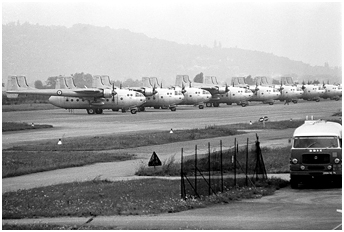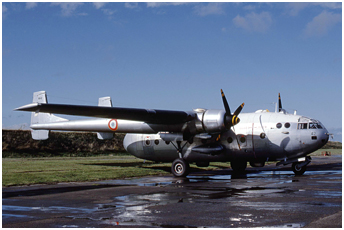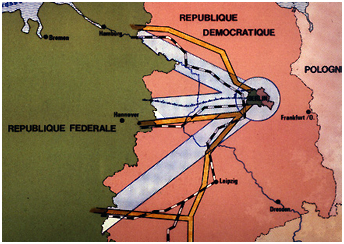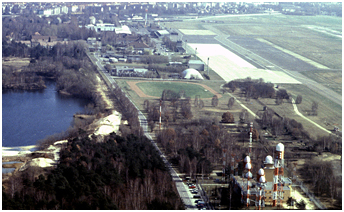
 Jean-Marie Sirougnet flew 75 electronic warfare missions as a radio communications intercept operator aboard the
Nord 2501 « Gabriel » of the Escadron Electronique 54 « Dunkerque » based at Metz-Frescaty. He recalls for us
an eventful mission that took place in December 1981.
Jean-Marie Sirougnet flew 75 electronic warfare missions as a radio communications intercept operator aboard the
Nord 2501 « Gabriel » of the Escadron Electronique 54 « Dunkerque » based at Metz-Frescaty. He recalls for us
an eventful mission that took place in December 1981.
An electronic intelligence mission was triggered by two factors: a regular or routine mission at least once a week or a specific and well-defined mission in response to the activity of the "other side" - the Warsaw Pact forces - or in anticipation thereof.
The Nord 2501 Noratlas « Gabriel »
 For these missions, we flew aboard the Nord 2501 "Gabriel", a modified Noratlas. They had no markings except for the two-digit serial number.
Inside, besides the "front-end" crew, the "back-end" team was composed of two radar operators responsible for searching for radars, five linguists
(Russian, German, or Czech depending on the mission), an analyst and a radio operator handling air navigation. The latter was responsible for
copying the call sign and the frequency of every new navigation or approach beacon that could betray a new airfield or active exercise area.
In addition, he reported the azimuth of the beacons compared to the aircraft using the ADF. A team leader with extensive knowledge of the potential
adversary led these "warriors of the airwaves." He was responsible for preparing a précis of the "Secret Défense" (classified) mission upon his return.
For these missions, we flew aboard the Nord 2501 "Gabriel", a modified Noratlas. They had no markings except for the two-digit serial number.
Inside, besides the "front-end" crew, the "back-end" team was composed of two radar operators responsible for searching for radars, five linguists
(Russian, German, or Czech depending on the mission), an analyst and a radio operator handling air navigation. The latter was responsible for
copying the call sign and the frequency of every new navigation or approach beacon that could betray a new airfield or active exercise area.
In addition, he reported the azimuth of the beacons compared to the aircraft using the ADF. A team leader with extensive knowledge of the potential
adversary led these "warriors of the airwaves." He was responsible for preparing a précis of the "Secret Défense" (classified) mission upon his return.
Mission 5489
 December 1981. I knew a few days ahead of time that I would take part in mission n°5489 on December 21st. It was 0900 hours and, in the briefing room,
the "back-enders" were already in flying suits listening carefully their chief, who specified the targets and the conduct of the mission: takeoff around
1300 hours, fly the Southern air corridor in to Berlin, overnight in Berlin, take off the next day after dinner for a flight via the Northern corridor to
reach the Baltic Sea, and back to Metz. The mission was called "Baltic" because of its configuration. The weather forecast was not great: a cold front was
anticipated over Northern Germany for the next 48 hours. In that period of the year, it meant snow on the ground and icing at altitude. We would have to be
on guard! It was time to go to the apron and the Noratlas n°42, already surrounded by mechanics and the "front-end" crew. Once inside, one must get his package
that includes a parachute and its harness. We donned the latter with the secret hope that we wouldn’t have to hook up the reserve chute, which would allow us
to leave the aircraft should something untoward happen. At that time of the year, the Noratlas was a real refrigerator and, until the engines were
started, we were rather frozen.
December 1981. I knew a few days ahead of time that I would take part in mission n°5489 on December 21st. It was 0900 hours and, in the briefing room,
the "back-enders" were already in flying suits listening carefully their chief, who specified the targets and the conduct of the mission: takeoff around
1300 hours, fly the Southern air corridor in to Berlin, overnight in Berlin, take off the next day after dinner for a flight via the Northern corridor to
reach the Baltic Sea, and back to Metz. The mission was called "Baltic" because of its configuration. The weather forecast was not great: a cold front was
anticipated over Northern Germany for the next 48 hours. In that period of the year, it meant snow on the ground and icing at altitude. We would have to be
on guard! It was time to go to the apron and the Noratlas n°42, already surrounded by mechanics and the "front-end" crew. Once inside, one must get his package
that includes a parachute and its harness. We donned the latter with the secret hope that we wouldn’t have to hook up the reserve chute, which would allow us
to leave the aircraft should something untoward happen. At that time of the year, the Noratlas was a real refrigerator and, until the engines were
started, we were rather frozen.
Mission preparations
We appreciated the engine tests, as the temperature starts to rise and, even if it is shaking violently in the rear, that's more pleasant. Maximum rpm for the right engine, feathering, throttle reduced, maximum rpm for the left engine, feathering, throttle reduced and, finally, both engines at full throttle and more shaking! It's the Grise (Grey) (1)! We lined up at the runway threshold... 2800 rpm full throttle, we were gone! A few minutes later during the climb to cruising altitude heading north to Luxembourg, the team leader would start the turbine powering the receivers. Operators could then verify the proper functioning of their VHF, UHF and MF radios as well as the scope (2); it is at this point that, during a previous mission, I had the unpleasant surprise to have the fuse of my radio blow. Although lacking a spare on board, there was no question of turning back for a blown fuse. I spent the mission as a passenger, counting sheep! A real mess! Once past Luxembourg, we took a course of 90° east.
Inside the Southern corridor
 Les voies d'accès aériennes, terrestres et maritimes vers Berlin-Ouest.
Les voies d'accès aériennes, terrestres et maritimes vers Berlin-Ouest.
Air, land and sea acces pathways to West Berlin.
Before entering the Southern corridor to Berlin, the first communications from Soviet and East German fighters were intercepted, recorded and translated at
the same time. We took a new course after Fulda. We approached the corridor and, in ten minutes, the Iron Curtain would be crossed at an altitude of about 8200 feet,
sometimes much lower if a photo mission is prescribed. Each operator knew now that he was at the frontline and that he had to intercept the maximum amount
of communications. I had to use my radio to check known beacons, whether active or inactive, and search for new ones. Engine noise was such that we often had to increase
reception volume in order to pull in the weak emission from an unknown beacon installed for a training range, or a highway section activated for flight operations. After
several hours under this regime, we begin to suffer from tinnitus, which took a long time to dissipate.
Berlin-Tegel

 The descent to Berlin-Tegel did not disturb the operators. On the contrary, most of the time, they were still listening to a Soviet or East German pilot while the aircraft
is taxiing to its parking place. It is only when the team leader powers down the turbine that they removed their headset! We spent the night in Berlin playing tarot sometimes
late into the night. We visited Berlin "by night" or the "Münchner," a well-known tavern where the beer was flowing in one-liter bocks. It was now December 22, 1981; we are
again in the Noratlas in early afternoon, always so cold before the start. I was the only one to put his headphones on, because I awaited the time signal from the radio-navigator
in order to obtain accurate records with the ADF.
The descent to Berlin-Tegel did not disturb the operators. On the contrary, most of the time, they were still listening to a Soviet or East German pilot while the aircraft
is taxiing to its parking place. It is only when the team leader powers down the turbine that they removed their headset! We spent the night in Berlin playing tarot sometimes
late into the night. We visited Berlin "by night" or the "Münchner," a well-known tavern where the beer was flowing in one-liter bocks. It was now December 22, 1981; we are
again in the Noratlas in early afternoon, always so cold before the start. I was the only one to put his headphones on, because I awaited the time signal from the radio-navigator
in order to obtain accurate records with the ADF.
Mission over Northern Germany
We overflew East Germany through the Northern corridor. Once back over the FRG, we turned right and headed due north towards the Baltic Sea. The "other side" was very active: the linguists had their noses in their classified notes and they had no time to chat with their colleagues. The weather was deteriorating above Northern Germany, the engines rpm increased and I felt that we were gaining some altitude. After three hours, I removed my helmet for a moment of rest; my ears were saturated with signals and I took some breaths from the oxygen mask. I then threw a questioning look on my neighbor who had filled pages and pages of intercepted dialogues of Soviet pilots. He couldn't lose track of "comrade Ivanovich"! He looked at me, disillusioned: "To each his own, man!" We headed to a course of 70 degrees. A few minutes later, I thought I heard a thud; I listened carefully, but there was nothing more. Then again came two stronger strokes. I was certain this time, and all the other operators heard it as well. Is somebody shooting at us? I turned to the colleague to my left and shouted in his ear: "What is it?" "Ice!" he replied. I understood what was going on: the ice breaking away from the leading edge of the wing had just violently struck the fuselage, which meant that we were in icing conditions. Knowing the consequences this could have for the plane, overweight and with flying controls locked, I was somewhat worried.
notes
(1)
Nickname of the Noratlas.
(2)
Spectrum and radar analyzer receiver used essentially to intercept SAM batteries and, to a lesser extent, any other ASR (revolution time - pulses characteristic)
 |
Mission 5489 > Part 2 |
 |
Plan du site - Sitemap |  |
